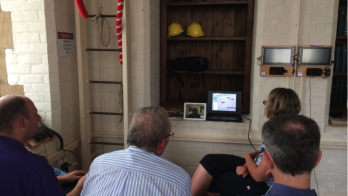M1: 12 Nov 2013 - Adelaide
Six of our local experienced ringers completed the day course of Module 1 of the Integrated Teacher Training Scheme at the Adelaide Ringing Centre in November and December. Unlike the usual format, we used a Skype link with Graham Nabb in England, who kindly agreed to get up early on a Tuesday morning so that we could have a series of 2-hour theory and practical sessions prior to Tuesday evening practices.
This was our first real test of the Internet and classroom facilities at the Adelaide Ringing Centre, except for our first session which had to taken off-site, as the Cathedral had hired a crane to inspect the entire Cathedral structure on the day, following wind damage to the roof.
Essentially the Integrated Teacher Training Scheme (ITTS): Module 1 encompasses all the required skills for a willing ringer of a good standard to commence teaching new ringers. The course provides the potential new teacher with strategies, techniques, and a system by which to undertake the task of teaching bell handling to a new ringer. Our practical sessions took place in Adelaide Ringing Centre; this enabled us to run through the various practical exercises without disturbing the neighbours.
The ITTS course is very interactive – the theory sessions were much more of a discussion than a lecture, and the practical sessions allowed us to develop new skills. We worked in pairs, with the more experienced teacher acting as mentor. It is difficult for an experienced ringer to simulate common handling faults but we achieved this to some degree by learning to ring left-handed!
I have had minimal involvement in teaching complete beginners; as such I found the course very informative and useful. Not only are various techniques and tools discussed but the course also provides insightful information on how we learn, one particular element was the concept of breaking down the action of ringing into small bite-size tasks. All of which, when put together, result in good handling whilst ringing a bell. Also discussed was how best to maintain enthusiasm and motivation of the learner. Much of this seemed to be common sense but hearing it highlighted and put into the context of teaching a learner was brilliant. I feel that the course has provided me the confidence to start applying what I have learnt.
The delivery methods for this course proved up to the challenge. Although we had issues with internet connection and sound volume, by using an iPad with internet connection to see Graham plus a laptop for the power point presentation we got on fine. Likewise, having multiple shorter sessions (as opposed to a 1 day course) was also good. Between sessions we would get together to practise and review what we had learned. This was also very beneficial.
All in all, I would recommend the course to anyone interested in learning to become a teacher. Considering we had 2 experienced bell ringing teachers in the group who attended the course, both of whom (I believe) managed to take away something new and useful to apply to future students. Not to mention that I was great fun!
With six ringing teachers having confidence and newly developed skills, we have a renewed focus at our open practices on reviewing and fixing handling styles which had already developed. This has highlighted for us that it is much easier to teach skills properly in the first place, than to fix them later!
Our training is not complete. The next step for our new teachers is to consolidate teaching skills by successfully teaching a new ringer. We are also about to start the Module 2 course – on teaching change ringing, again via Skype.
Saskia Noorduijn

Course Tutor: Graham Nabb
Teaching Bell Handling
Practical advice for teachers, right from the first lesson.